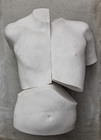Stephen Ralph — Gravity
exhibition text by Georgina Cole
The sculptures in Stephen Ralph’s exhibition Gravity represent the convergence of two artistic trajectories: a formalist concern with the principles of matter, weight, direction, and space, and the classical, figurative tradition of the expressive nude body. Each work is an arrangement of body parts in a state of precarious balance. Instead of standing up, the sculptures lie down in prone heaps, supported by concrete plinths spaced in a staccato rhythm across the gallery floor. The forms are derived from life casts in plaster of the artist’s two sons, which are then cut into pieces and finely modelled in Chillagoe marble. These bodily fragments are treated as distinct shapes, the cut edges subjected to a process of abstraction that exaggerates or refines the interventions of the angle-grinder. As sculptures, the body parts are re-aggregated according to a new logic. They balance, lean, and rest on each other, relying on gravity rather than a structure of bones, muscles, and ligaments.
The unity and autonomy of the body is thus sacrificed to the laws of matter. In the work called Gravity, a pair of reclining legs, sliced into segments at the ankles and thighs, slip out of alignment, falling into a new horizontal configuration. Another work, called Evan’s Crown, presents a torso divided into three volumes that don’t quite fit together. The gently curved edges of the shapes soften the brutality of the dissection but prevent the re-unification of parts. Smooth and spare, the body is recomposed as forms in space, evoking the balanced boulders of their geological namesake.
The chill sparkle of the marble and the detached physics of abstraction belie, however, the personal significance of these works. These pale fragments are sculptural responses to death, illness, and separation. Indeed, the slender, youthful bodies of the artist’s sons, repeatedly dismantled and recombined, stand in for Ralph’s own body dissected and rebuilt on the operating table. In The Promise of Company, two lower limbs severed at the thighs and the ankles are laid out flat on a plinth, evoking a state of sleep or death. Rolled slightly toward one another they look vulnerable and slight. A small piece of cloth draped over one shin is a poignant sign of human touch and care: an attempt, perhaps, to comfort the sick and dying.
A key reference point for many of the works is Théodore Géricault’s Raft of the Medusa of 1818-19, particularly the studies made for the monumental painting. To convey the physical and psychological torment of the 147 passengers abandoned to a hastily-built raft after the wreck of the French frigate (of which 15 survived), Géricault made several visits to the morgues and dissection theatres of Paris to study the shapes and decay of severed heads and limbs.[1] The resulting oil paintings of disjointed body parts are morbid yet surprisingly tender, the incongruously paired arms and legs gently intertwined, as if in repose or embrace.
In Ralph’s work, the shock of dismemberment is largely mitigated by compositional balance and the luminosity of marble. In It Can’t be Tree, two hands, fingers eloquently outstretched, are poised on a mismatched pair of arms, one encircled by drapery just beneath the shoulder. The fingers strain against the pull of gravity, yet the limbs are pliant and heavy, creating a stable horizontal platform. Unlike the rippling musculature of the figures on Géricault’s raft, who form a desperate human pyramid to signal a boat on the horizon, Ralph’s bodies are mostly passive and acquiescent, submitting to their fate without struggle. They emulate, rather, the slack grace of the dead youth sprawled in a man’s lap at the painting’s left-hand corner.
The beauty of marble and youth provide solace; a way of acknowledging and working through inexorable loss. In Dead Wood, Ralph develops the anatomical connection between body and tree, a theme of his 2021 exhibition of marble sculptures, Life is Long, in which human legs emerged from bark-clad trunks. By contrast to the power and sensuality of the earlier works, the conjunction between human and tree limb is here a site of trauma. A right shoulder is conjoined awkwardly to the left arm, creating an uncomfortable and dysfunctional assemblage. From the forearm juts the rough, broken end of a dead branch. The flesh appears to fuse around the lifeless timber, just as the living wood of a eucalyptus tree does in times of drought to allow a dead branch to drop. The combination of living flesh and dead wood evokes the difficulty of the healing process, and the necessity of letting go.
Moreover, the marble itself contains a reminder of the inevitable yet passing nature of suffering. Inside the cavity of the torso, the stone is left rough and crystalline, pointing to its geological time scale and the physical forces of heat and pressure necessary for its production. The ancient metamorphic rock, which will outlast tree and man, underlines the transience of physical, existential, and psychological torment. There are powers at work here that simply dwarf human experience.
These sculptures invite us to recognise the power of art to take us beyond the immediate concerns of our own existence. As the moral philosopher and novelist Iris Murdoch argued, beauty enables one “to pierce the veil of selfish consciousness and join the world as it really is”.[2] Ralph’s sculptures are the products of taking consolation in the beauty of art and nature. Their honest treatment of pain and fear is surely the result of art’s ability to clarify our sense of reality, and to remind us of our miniscule part in it.
Georgina Cole is a lecturer of Art History and Theory at the National Art School, Sydney
[1] Nina Athanassoglou-Kallmyer, “Géricault’s severed heads and limbs: the politics and aesthetics of the scaffold”, The Art Bulletin 74, no. 4 (1992): 599-602.
[2] Iris Murdoch, The Sovereignty of Good (New York: Schocken Books, 1971), 93.















